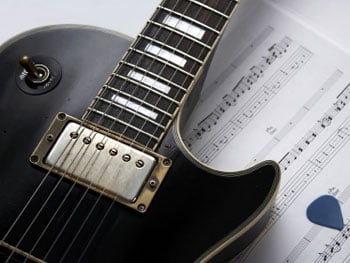Theory Glossary
(→H) |
(→B) |
||
| Line 25: | Line 25: | ||
== B == | == B == | ||
| + | '''Bar:''' A regular collection of notes, each of the same duration in terms of the number of notes it contains. The duration of a bar in note terms is defined at the beginning by the time signature. | ||
== C == | == C == | ||
Revision as of 04:00, 19 January 2008
Contents |
Theory Glossary
A list of musical theory terminology - the essential reference for theory students!
Note: Links to Andrew's Theory Lessons can be found in some terms.
--FretDancer69 03:33, 19 January 2008 (UTC)
A B C D E F G H I J K L M N O P Q R S T U V W X Y Z
A
Accidental: A note that falls outside the key signature.
Arpeggio: Notes from from a chord played one at a time.
Augmented Triad: Triad consisting of a root note, a major 3rd, an an Augmented 5th.
B
Bar: A regular collection of notes, each of the same duration in terms of the number of notes it contains. The duration of a bar in note terms is defined at the beginning by the time signature.
C
Chord: A number of notes played together at the same time.
Circle of Fifths: An arrangement of musical keys in a circular format. Allows you to easily understand the relationship between keys, and work out the number of sharps and flats there are in each key.
D
Diminished Triad: Triad consisting of a root note, a minor 3rd, and a diminished 5th.
E
F
Flat: Lowers a note by one semi-tone. It is written as "b".
G
H
Harmony: An enhancement of a melody line by playing notes at the same time either higher or lower than the melody note itself.
Hexatonic Scale: A scale with six notes per octave.
I
Interval: The distance between two notes.
J
K
Key Signature: Shows the key that a piece is to be played in.It is written as a group of symbols at the beginning of the piece of music, listing either a number of sharps (#) or flats.
L
M
Major Triad: Triad consisting of a root note, a 3rd, and a Perfect 5th.
Minor Triad: Triad consisting of a root note, a minor 3rd, and a Perfect 5th.
Mode: A variaton of a scale used to create different effects within a song. The modes are: Ionian, Dorian, Phrygian, Lydian, Mixolydian, Aeolian and Locrian. Each mode possesses a different formula. The Ionian mode is another name for the Major Scale and therefore posseses the same formula. The Aeolian mode is another name for the Minor Scale and it too, possesses the minor scale's formula.
N
O
Octave: Interval between two notes with half or double its frequency. These two notes share the same name.
P
Pentatonic Scale: A scale with five notes per octave.
Powerchord: Two notes played together, a root note and a Perfect 5th interval, sometimes the root note's octave is added as well.
Q
R
Root Note: The note(s) that define the sound of the scale. The scale is named after its root note.
S
Scale: A set of notes that have a particular sound or feeling to it.
Sharp: Raises a note by one semi-tone. It is written as "#".
Stave: The series of vertical lines that music notation is based around. Staves are composed of five lines, these lines do not represents the strings on the guitar. --> Go to Music Notation Lesson <--
T
Time Signature: Used in sheet music. Specifies how many beats are in each measure and one note value constitutes one beat.
Triad: The simplest form of a chord that contains at least 3 notes, root note, major third and perfect 5th. There are also other types of triads with different formulas.






